-ing形式之现在分词(讲义)
- 格式:docx
- 大小:22.15 KB
- 文档页数:5
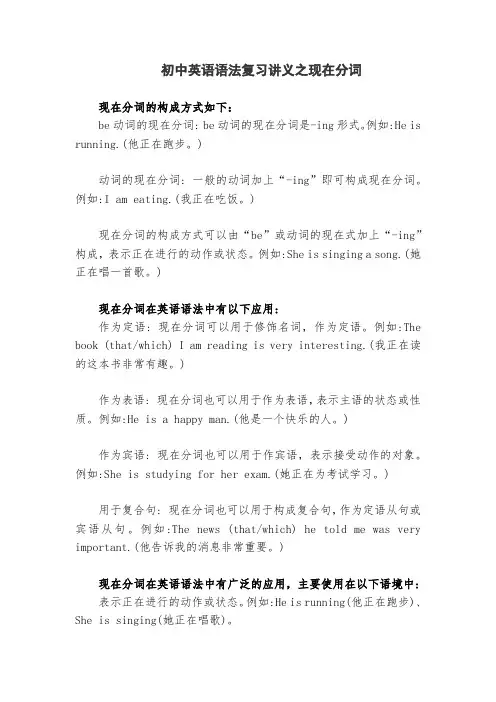
初中英语语法复习讲义之现在分词现在分词的构成方式如下:be动词的现在分词: be动词的现在分词是-ing形式。
例如:He is running.(他正在跑步。
)动词的现在分词: 一般的动词加上“-ing”即可构成现在分词。
例如:I am eating.(我正在吃饭。
)现在分词的构成方式可以由“be”或动词的现在式加上“-ing”构成,表示正在进行的动作或状态。
例如:She is singing a song.(她正在唱一首歌。
)现在分词在英语语法中有以下应用:作为定语: 现在分词可以用于修饰名词,作为定语。
例如:The book (that/which) I am reading is very interesting.(我正在读的这本书非常有趣。
)作为表语: 现在分词也可以用于作为表语,表示主语的状态或性质。
例如:He is a happy man.(他是一个快乐的人。
)作为宾语: 现在分词也可以用于作宾语,表示接受动作的对象。
例如:She is studying for her exam.(她正在为考试学习。
)用于复合句: 现在分词也可以用于构成复合句,作为定语从句或宾语从句。
例如:The news (that/which) he told me was very important.(他告诉我的消息非常重要。
)现在分词在英语语法中有广泛的应用,主要使用在以下语境中:表示正在进行的动作或状态。
例如:He is running(他正在跑步)、She is singing(她正在唱歌)。
作为定语修饰名词。
例如:The book (that/which) I am reading is very interesting(我正在读的这本书非常有趣)。
作为表语表示主语的状态或性质。
例如:He is a happy man(他是一个快乐的人)。
作为宾语表示接受动作的对象。
例如:She is studying for her exam(她正在为考试学习)。

14.突破语法知识—非谓语动词之现在分词一、动词-ing形式概述动词-ing形式包括现在分词(the present participle)和动名词,是三种非谓语动词之一。
现在分词既具有动词的一些特征,又具有形容词和副词的句法功能。
动名词既具有动词的一些特征,又具有名词的句法功能。
动词-ing形式的功能动词-ing的形式:1.He hurried home,looking behind as he went.2.Having finished their work,they had a rest.3.The large building being built is a library.4.Having been shown the lab,we were taken to see the library.二、现在分词的两个基本特点1、在时间上表示动作正在进行There are many sleeping students in class.2、在语态上表示主动Feeling the lesson is boring,the students are sleepy.三、现在分词的构成1、一般动词,变化:加+ing,例子:wash——washing,read——reading2、以不发音字母e结尾的动词,变化:去掉e,再加+ing,例如:make——making write——writing use——using3、以重读闭音节结尾的动词且末尾只有一个辅音字母,变化:双写最后的辅音字母,再加+ing,例如:run——running,swim——swimming,put——putting4、以ie结尾的动词,变化:改ie为y,再加+ing,例如:lie——lying,die——dying,tie——tying5、以c结尾的动词,变化:变c为ck,再加+ing,例子:picnic→picnicking,traffic→trafficking(例外:arc 作弧形运动,arcing)6、以l结尾的动词,变化:如果动词原形以非重读音节结尾,则末尾的字母l双写与不双写均可。
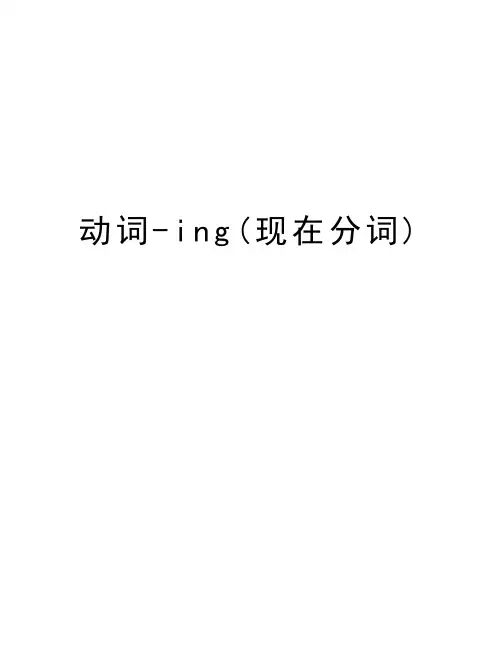
动词-i n g(现在分词)动词-ing 形式 (1)英语课程标准将“动名词”和“现在分词”合称为“动词-ing”形式。
作为非谓语动词的一种形式,动词-ing具有名词,形容词和副词的特点,它可以在句中作除了谓语以外的所有句子成分。
一.动词-ing 形式的构成Not being done / not having been done二.动词-ing 形式作定语1)单个动词-ing形式作定语放在被修饰的名词前,叫做前置定语。
2)动词-ing短语作定语,通常放在被修饰的名词后,叫做后置定语。
3) having (been) done 该结构不能用作后置定语。
作用:1)表示用途A smoking room 吸烟室 a walking stick 拐杖 drinking water饮用水A sleeping pill 安眠药 drawing board 画板 parking lot 停车场Swimming pool 游泳池 teaching building 教学楼 changing room 更衣室Driving permit 驾驶许可证 a waiting room 候车室2)表示动作boiling water 正在沸腾的水 developing countries 发展中国家the setting sun 落日 the rising sun 冉冉升起的太阳in the following days 在接下来的几天 the coming week 下一周3) 表所修饰名词正在进行的动作,可替换成定语从句。
[备注] 此时该动词和被修饰的名词之间是主动关系A walking man = a man who is walkingA sleeping child= a child who is sleeping.The man standing at the gate is my grandpa.= The man _______________________ at the gate is my grandpa.[拓展]The computer ___________(repair) now is my brothers.三.动词-ing 形式作表语➢动词-ing形式作表语,说明主语的具体内容。
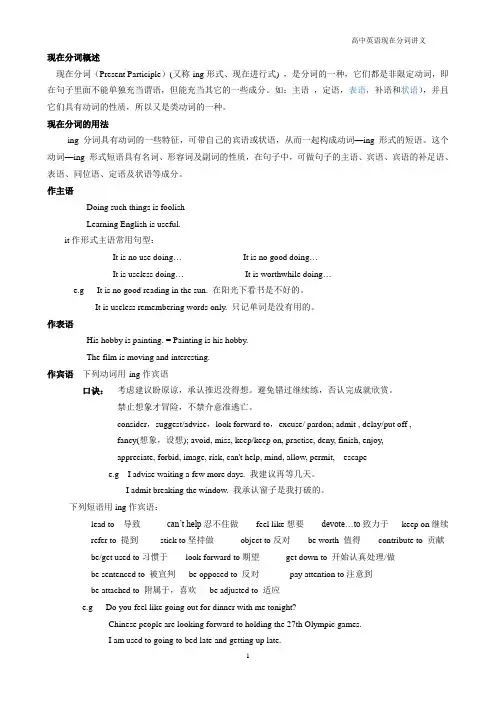
现在分词概述现在分词(Present Participle)(又称-ing形式、现在进行式) ,是分词的一种,它们都是非限定动词,即在句子里面不能单独充当谓语,但能充当其它的一些成分。
如:主语,定语,表语,补语和状语),并且它们具有动词的性质,所以又是类动词的一种。
现在分词的用法-ing分词具有动词的一些特征,可带自己的宾语或状语,从而一起构成动词—ing 形式的短语。
这个动词—ing 形式短语具有名词、形容词及副词的性质,在句子中,可做句子的主语、宾语、宾语的补足语、表语、同位语、定语及状语等成分。
作主语Doing such things is foolishLearning English is useful.it作形式主语常用句型:It is no use doing…It is no good doing…It is useless doing…It is worthwhile doing…e.g It is no good reading in the sun. 在阳光下看书是不好的。
It is useless remembering words only. 只记单词是没有用的。
作表语His hobby is painting. = Painting is his hobby.The film is moving and interesting.作宾语下列动词用-ing作宾语口诀:考虑建议盼原谅,承认推迟没得想。
避免错过继续练,否认完成就欣赏。
禁止想象才冒险,不禁介意准逃亡。
consider,suggest/advise,look forward to,excuse/ pardon; admit , delay/put off ,fancy(想象,设想); avoid, miss, keep/keep on, practise, deny, finish, enjoy,appreciate, forbid, image, risk, can't help, mind, allow, permit, escapee.g I advise waiting a few more days. 我建议再等几天。

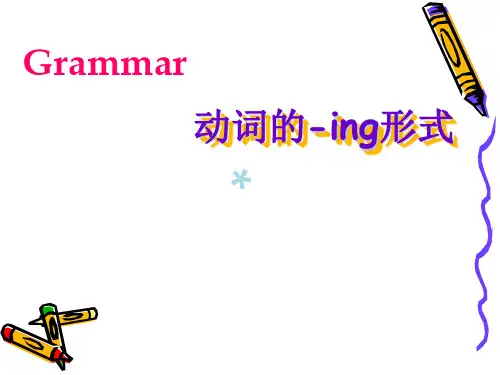

第十三章动词-ing形式思维导图知识梳理一、动名词的定义动词-ing形式分为两类:动名词和现在分词.动名词在句中起名词作用,现在分词在句中起形容词或副词作用.动名词是一种动词的非谓语形式,它兼有动词和名词的特征,由动词原形加词尾-ing而成,其构成法与现在分词一样.动名词有时态和语态的变化.(以do为例)从性质上讲,动词的-ing形式相当于名词、形容词、副词.因此,它在句中可用作主语、表语、定语、宾语、状语和宾语补足语.(一)作主语动词-ing形式作主语通常表示一种抽象的动作概念,即泛指某种行为或动作.Eating too much is bad for your health.吃得太多对身体健康有害.Is playing basketball after lunch good or bad for your health?吃完午饭就打篮球对身体健康有益还是有害?Travelling abroad can widen one's outlook.出国旅行会扩大人们的视野.点拨(1)动词-ing形式短语作主语,通常有两种位置:一是放在句首,如上述例句所示;一是用it作形式主语,而将-ing分词短语移到谓语部分之后,以避免句子结构头重脚轻.Having his brother here will make him happier.It will make him happier having his brother here.让他的兄弟待在这里将会使他高兴一些.Swimming in this river is dangerous.It is dangerous swimming in this river.在这条河中游泳很危险.(2)动词-ing形式作主语还可以用于“There is no+-ing形式”(····是不可能的)结构.There is no smoking here.这里不许吸烟.There is no joking about such matters.这件事开不得玩笑.(二)作表语动词-ing形式(短语)作表语有时起名词作用,泛指动作,有时起形容词作用,指主语的性质、状态.His hobby is collecting stamps.他的爱好是集邮.The news is exciting.这消息令人兴奋.The food smells inviting.这道菜香味怡人.My favourite sport is playing table tennis.我最喜欢的运动是乒乓球.The only thing she is interested in is dancing.她唯一感兴趣的就是跳舞.点拨不要把作表语的-ing形式与进行时态相混淆.-ing形式作表语表示主语的某种特征,而进行时态则表示正在进行的动作.试比较:Her job is teaching.她的工作是教书.(teaching是表语)She is teaching there now.她正在那儿上课.(is teaching是现在进行时态)(三)作定语动词-ing形式作定语只表明它所修饰的词的用途、所属关系等,置于被修饰词之前.a working method工作方法a dining car餐车a swimming pool游泳池building materials建材(四)作宾语在某些动词:suggest,finish,avoid,stop,can't help,mind(在乎),admit,advise,consider,deny,enjoy,require, postpone,delay,practise,fancy,excuse,pardon,miss(错过)等后面不能用不定式,而必须用动名词作为宾语.I can't help laughing.我禁不住笑了起来.Return the book to the library as soon as you finish reading it.你一看完这本书就还回图书馆.He enjoys watching TV plays.他喜欢看电视剧.点拨有些动词后既可用动名词,也可用不定式.在动词love,like,begin,start,continue等后,既可用动名词作宾语,也可用不定式作宾语,有时两种结构的意义差别不大.(五)作宾语补足语动词的-ing形式用作宾语补足语,常用在:see,hear,notice,watch,keep,find,feel,get,have等动词之后,与一个名词或代词构成复合宾语;其中宾语和宾语补足语是主谓关系.I saw him walking across the street.我看见他穿过街道.He kept me waiting for a long time.他让我等了很长时间.We watched the army marching down the street towards the park.我们观看部队沿街道朝公园行走.I heard her playing the piano.我听见她在弹钢琴.点拨在see,hear,feel,watch,notice等动词之后,既可用动词-ing形式也可用(不带to的)动词不定式作宾语补足语:如用动词-ing形式,通常表示动作正在进行;用动词不定式,则表示(或强调)动作从开始到结束的全过程.(六)作状语动词的-ing形式短语作状语时,通常都表示主语正在进行的另一动作,用来对谓语动词表示的动作加以修饰或作为陪衬,它可表示时间、原因、结果、条件、让步、方式或伴随动作,相当于相对应的状语从句.Seeing the teacher entering the room,the students stood up.=When the students saw the teacher entering the room,they stood up.学生(们)看见老师进房间,都站了起来.(两个动作同时发生)Being ill,I went home.=Because I was ill,I went home.由于生病,我回家了.The snow lasted a week,resulting in a serious traffic confusion in the whole area.=The snow lasted a week,so it resulted in a serious traffic confusion in the whole area.雪下了一个星期,造成整个地方的严重交通混乱.Be careful when crossing the street.过马路时,要小心.The students walked out of the classroom,laughing and talking.学生们有说有笑走出教室.点拨动名词也可以和about,against,at,before,after,by,besides,for,from,in,on,upon,without等介词构成短语,作状语用.Without saying good-bye,she left him.未告别,她就离开了他.After reading the passage twice,he began to do the exercises.这段文章看了两遍后,他就开始做练习了.Upon returning from Beijing,he went to visit his friend.从北京一回来,他马上就去拜访朋友.三、-ing分词的否定式-ing分词是动词的一种非限定形式,其否定式是一律在其前面加否定词“not”或“never”构成.如:I think it will do you a lot of good not going.我觉得不去对你会有好处的.I left at noon,not staying for lunch.我是中午走的,没有留下来吃午饭.I'm sorry for not having informed you of the meeting.抱歉没通知你开会.I regret not having gone together with her.我后悔没有跟她一起去.四、-ing分词常用于下列句型中It's no use...It's no good...Having difficulty/trouble...There is no...It's no use doing experiments but not considering the results.不考虑结果做实验没有用.It's no good not combining theory with practice.不把理论和实践结合就没有用.I have trouble running a long distance.我跑长跑有困难.There is no denying the fact that we are still backward.不容否认,我们仍然落后.五、动名词的独立主格结构-ing分词也可以用于独立主格结构,由“主格名词或代词+-ing分词”构成,表示时间、条件、原因、伴随情况等.The clock striking eight,they began working.时钟敲了8响,他们就开始工作了.(表示时间)The weather being fine,we went for a walk.由于天气好,我们出去散散步.(表示原因)Time permitting,we'll come to see you.如果时间允许,我们就来看你.(表示条件)也可由“with/without+宾语+-ing分词”构成独立主格结构,表示伴随情况.如:You must not sit with your feet pointing at another person.坐着时不要把脚朝着别人.六、动名词作宾语和动词不定式作宾语含义不同部分动词可加动名词作宾语,也可加动词不定式作宾语,但意思不同,如:(一)remember doing sth.表示“记得过去做过的一件事”,remember to do sth.表示“记得要去做某事”I remember seeing him once somewhere.我记得在哪里见过他一次.Remember to see him before he goes away.记住在他离开之前看他.(二)regret doing sth.表示“对过去做过的事情后悔”,regret to do sth.表示“对还没做或将要做的事情表示遗憾”I regret telling you the bad news.我后悔把这个坏消息告诉你.I regret to say I'm unable to help you.很抱歉我不能帮助你.(三)stop doing sth.表示“停止正在做的事情”,stop to do sth.表示“停止什么,然后去做另一件事情”Let's stop talking about it.咱们停止谈论这件事情吧.We stopped to see what happened.我们停下来去看发生了什么事情.(四)forget doing sth.表示“忘记曾做过某事”,forget to do sth.表示“忘记去做某事”I forgot giving the letter to her.我忘了,已经把信给她了.I forgot to post the letter.我忘记发信了.(五)try doing sth.表示“尝试着做某事”,try to do sth.表示“设法做某事”Let's try doing the work some other way.我们用别的方法做这工作试试.We must try to get everything done in time.我们必须设法及时把一切搞好.(六)mean doing sth.表示“意味着,意思是”,mean to do sth.表示“打算、想要”This means helping you.这意味着帮助你.I mean to help him with it.我打算帮助他做这件事情.七、一些与动词-ing形式有关的短语(一)表示有目的、有意识地进行练习或训练某项技能:do+(some)+v.-ingdo some reading读读书do some running跑跑步do some writing练练字This year I am going to do more speaking.今年我要多练口语.(二)表示做一些笼统、不具体指明的事:do+(some)+v.-ingdo some shopping去商店买东西(不指明买哪样具体的东西)do some washing洗东西do some cooking做饭do some cleaning扫除do some sewing缝纫(三)“go+v.-ing形式”大部分表示从事运动、消遣或娱乐活动go dancing去跳舞go swimming去游泳go skating去滑冰go skiing去滑雪go shooting去射击go boating去划船go fishing去钓鱼go hunting去打猎go riding去骑马go walking去散步go running去跑步go sailing去航海八、-ing分词时态及语态(一)-ing分词的特点:-ing分词的时态分为一般式和完成式.一般式所表示的动作与谓语动词的动作往往同时发生.完成式所表示的动作发生在谓语动词的动作之前.He insisted on finishing the work before going home.他坚持在回家前一定要先完成工作.He didn't mention having met me.他没提及已见到了我.I still remember having ever worked together with him.我还记得曾经与他一起共过事.(二)-ing分词的语态-ing分词的被动语态也有一般式和完成式两种.The large house being built near the factory is a new hospital.工厂附近正在施工的大楼是一座新的医院.Having been sent to the wrong address,the letter did not reach her.那封信投错了地址,她没有收到.好题精练选择填空1.Taking pictures_________very interesting.A.isB.areC.to beD.be2._________the bad news made him cry.A.HearB.HeardC.HearingD.Is hearing3._________a desert had always been a risk adventure.A.being crossed.Having crossed C.Crossing D.To have crossed4.Before he came,I'd finished_________the whole book.A.to readB.to have readC.readingD.read5.I always enjoy_________to popular music at night.A.to listenB.listeningC.that I can listenD.if I can listen6.We are considering_________a trip around the island.A.takeB.to takeC.to be takingD.taking7.I hope you don't mind_________at your newspaper.A.I lookB.my lookingC.I lookingD.my to look8.When a man's heart stops_________,he dies.A.to beatB.beatingC.beatD.beaten9.I can't help_________he is still alive.A.thinkingB.thinkC.to thinkD.thought of10.So far as I am concerned,I prefer readingA.than meatB.for joyC.instead of sleeping D to drinking11.It goes without_________that knowledge is important.A.talkingB.tellingC.sayingD.mentioning12.we are looking forward_________our friends next week.A.to seeB.to seeingC.to be seeingD.shall see13.He spent a lot of money_________books and magazines.A.buyB.buyingC.to buyD.bought14.The silkworm is an insect worth_________.A.to knowB.knowingC.to be knownD.being known15.She went out without_________good-bye to us.A.sayB.to sayC.sayingD.being said16.The curious student kept on_________questions.A.asksB.askingC.to askD.asked17.He is such a strange person;there's_________what he'll do next.A.no knowingB.not to knowC.not knownD.being unknown18.When she heard the bad news,she burst_________.A.into cryingB.out to tearsC.cryingD.out crying19.You must never cross the street without_________the light to turn green.A.waitingB.to waitC.waiting forD.to wait for20.Scientists succeed_________protein out of old newspapers.A.to makeB.at makingC.makingD.in making21.I became_________after watching too much television.A.boredB.boringC.boreD.bores22.I felt_________by his interest in my new invention.A.encourage B to encourage C.was encouraged D.encouraged23.He sat there_________a novel.A.readB.readingC.readsD.had read24.Don't wake up the_________child.A.sleepB.sleptC.sleepingD.sleepy25.A proverb goes:"A_________stone gathers no moss”.A.rollB.rollingC.rolledD.rolls26.The heavy rain kept us_________for two hours.A.waitB.waitedC.waitingD.to wait27.I found a dog_________over by a car on the road.A.to runB.runC.ranD.running28.We found the baby_________on the floor.A.sleptB.sleepC.asleepD.sleeping29.Jack saw a woman_________near the dog,so he walked up to her.A.stoodB.standsC.to standD.standing30.They got their ca_________at the garage.A.be washedB.washedC.being washedD.to have been washed 31_________with his report,I told him to write it all over again.A.DissatisfactoryB.Not being satisfiedC.Having not satisfiedD.Dissatisfying32._________our shoes in our hands,we crossed the stream.A.To carryB.CarryingC.CarriedD.Carry33._________my homework,I went home.A.Having finishedB.FinishedC.Being finishedD.Finish34._________the door unlocked,I went in.A.FindingB.FoundC.Had foundD.Have found35._________a careless fellow,he forget all about it.A.IsB.BeC.BeingD.Was答案:1-5ACCCB6-10DBBAD11-15CBBBC16-20BADCD 21-25ADBCB26-30CBCDB 31-35BBAAC。
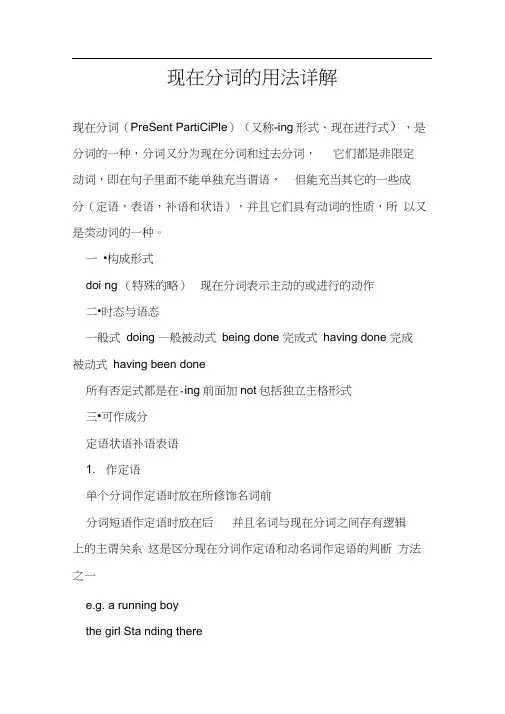
现在分词的用法详解现在分词(PreSent PartiCiPle)(又称-ing形式、现在进行式),是分词的一种,分词又分为现在分词和过去分词,它们都是非限定动词,即在句子里面不能单独充当谓语,但能充当其它的一些成分(定语,表语,补语和状语),并且它们具有动词的性质,所以又是类动词的一种。
一•构成形式doi ng (特殊的略)现在分词表示主动的或进行的动作二•时态与语态一般式doing —般被动式being done 完成式having done 完成被动式having been done所有否定式都是在-ing前面加not包括独立主格形式三•可作成分定语状语补语表语1. 作定语单个分词作定语时放在所修饰名词前分词短语作定语时放在后并且名词与现在分词之间存有逻辑上的主谓关系这是区分现在分词作定语和动名词作定语的判断方法之一e.g. a running boythe girl Sta nding there并且一般都可以转化为一个进行时的定语从句eg a boy WhO is runninga girl who is Sta nding there注意1 :分词的完成时不可作定语注意2:在message Ietter Sign news notice等词后要用现在分词作定语不用过去分词这是考试的易错点注意3 :某些现在分词作定语时已不再表示动作已经从分词变为了形容词词性eg. an interesting story an exciting match 这些也可以属于现在分词作定语但是不能转化为相应的定语从句但是可以有三级变化(原级比较级最高级)和被某些副词如Very修饰我们一般不说:The girl hav ing won the race is my deskmate.而常这样说:The girl who has won the race is my deskmate.done用作后置定语,表示被动,同时表示过去的时间,这种结构中一般都用及物动词。
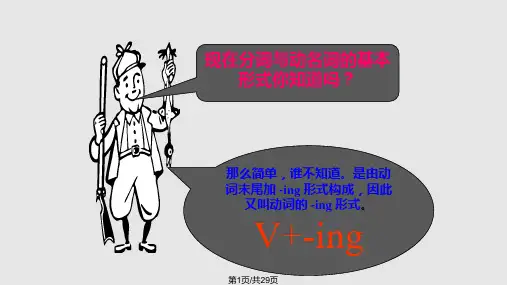

现在分词;动名词(1)作主语:Seeing is believing. 百闻不如一见。
Talking is easier than doing. 说比做容易。
作主语时,如果其结构较长,可用it作形式主语,而将作主语的-ing后置。
如:It isn’t much good writing to them again.It’s no use waiting here.(2)作表语:Her job is washing and cooking. My hobby is collecting stamps.(3)作宾语:①作及物动词的宾语。
She likes drawing very much.;②作某些短语动词的宾语。
Mary is thinking of going back to New York.;③ do+限定词(my, some, any, the等)+ -ing,表示“做…事”之意,如:We often do our cleaning on Saturday afternoon.Will you do any shopping on Saturday this afternoon?④作介词的宾语:Her sister is good at learning physics.;⑤作形容词worth, busy等的宾语:This book is well worth reading.⑥–ing作宾语带有宾语补足语时,要用it作为形式宾语,而将作宾语的-ing后置,如:We found it no good talking like that.Do you think it necessary trying again?(4)作定语:The sleeping child is only five years old.Do you know the man standing at the gate?(5)作宾语补足语:We can see steam rising from the wet clothes.可以带有这种复合宾语的动词有see, watch, hear, observe, feel, find, have, keep等。

-ing形式之现在分词(讲义)高中英语-ing形式之现在分词1. 通过学习本课,能够全面掌握现在分词的基本形式及其基本用法。
2. 通过学习本课,能够掌握现在分词作表语、定语和状语等句法功能。
重点:学生能够正确运用现在分词来解决语法填空和短文改错中的问题。
难点:学生能够运用句法功能及固定搭配等选用现在分词的正确形式。
1. 对动词-ing形式的考查历来是高考中的热点。
要求考生正确理解分词的句法功能,正确分析句子结构。
2. 高考对于现在分词的考查主要集中在语法填空和短文改错中,要求考生对适用现在分词的情况有足够的认知,能够准确判断出何时需要用现在分词形式。
现在分词的基本形式及其基本用法现在分词在形式上与动名词相同,由“动词+ing”构成,现在分词可以有不同的时态和语态,按照时态可以分作一般式和完成式,按照语态可以分作主动式和被动式。
类型结构意义一般式doing 表示动作正在进行或与谓语动作同时发生完成式having done 强调动作已经发生或者发生在谓语动作之前否定式not doing/not having done 一般式的否定式/完成式的否定式被动式being done/having been done 一般式的被动式/完成式的被动式here.”他朝我走来,说着“很高兴遇见你。
”The question being discussed is of great importance.正在被讨论的问题非常重要。
Having been scolded by his mother, he made up his mind to give up smoking.被母亲责怪过之后,他下定决心要戒烟。
Not knowing her address, I telephoned her to meet me at the airport.不知道她的地址,我打电话让她到机场接我。
Not having finished his homework, he had to stay up late last night.因为还没有写完作业,昨夜他不得不熬夜到很晚。
形式之现在分-in高中英语通过学习本课,能够全面掌握现在分词的基本形式及其基本用法。
1.通过学习本课,能够掌握现在分词作表语、定语和状语等句法功能。
2.学生能够正确运用现在分词来解决语法填空和短文改错中的问题。
重点:学生能够运用句法功能及固定搭配等选用现在分词的正确形式。
难点:正确形式的考查历来是高考中的热点。
要求考生正确理解分词的句法功能,1. 对动词-ing 分析句子结构。
高考对于现在分词的考查主要集中在语法填空和短文改错中,要求考生对适用现在分2.词的情况有足够的认知,能够准确判断出何时需要用现在分词形式。
现在分词的基本形式及其基本用法”构成,现在分词可以有不同的时态和现在分词在形式上与动名词相同,由“动词+ing 语态,按照时态可以分作一般式和完成式,按照语态可以分作主动式和被动式。
He came up to me, saying, “Glad to see you here.””他朝我走来,说着“很高兴遇见你。
The question being discussed is of great importance. 正在被讨论的问题非常重要。
Having been scolded by his mother, he made up his mind to give up smoking. 被母亲责怪过之后,他下定决心要戒烟。
Not knowing her address, I telephoned her to meet me at the airport. 不知道她的地址,我打电话让她到机场接我。
Not having finished his homework, he had to stay up late last night. 因为还没有写完作业,昨夜他不得不熬夜到很晚。
According to the report, people in the __________ areas are rebuilding their homes and manyroads __________ to the area have been repaired. A. flooded; leadB. flooding; leadingC. flooding; to leadD. flooded; leading D答案:洪灾区的人们正在重建他们的家园,并且很多通往灾区的路据报道,思路分析:句意:之间是逻辑上的主谓关系,故和leadflooded也已经修好了。
动词的-ing形式动词的-ing形式包括传统语法的“动名词”(gerund)和“现在分词”(present participle)两个部分。
动词的-ing形式具有动词的特征,同时又具有名词、形容词和副词的特征,因此它可以在句中作主语、表语、定语、宾语、宾语补足语和状语。
(1)动词的-ing形式作表语动词的-ing形式作表语的有两种不同的含义:1.表示主语的______是什么。
Her job is keeping the lecture hall as clean as possible.The real question is getting to know the needs of the students.2.表示主语具有的_______。
The problem is quite puzzling.It was astonishing to see the animals and plants that are found nowhere else in the world. 他的爱好是集邮。
这条消息令人失望。
那位领导的话令人吃惊。
(2)动词的-ing形式作___________.We heard the children shouting upstairs.They should not leave us wondering what they will do next.1.动词的-ing形式可以在see, hear, notice, watch, feel, smell, look at, listen to, observe, find等表示感官和心理状态的动词后面作宾语补足语,和一个名词或代词一起构成复合宾语。
We saw Li Dong coming into the Internet bar.我下车的时候注意到一个男人从银行里跑出来。
我觉得我的心在猛烈地跳动。
2.动词的-ing形式和不定式He saw a girl getting on the car.He saw a girl get on the car and drive off.Do you hear someone knocking at the doorDo you hear someone knock at the door.3.动词的-ing形式也可用在have, get, leave, keep, get, catchhave sb. doing sth.get sb./sth. doing sth.leave sb. doing sth.keep sb. doing sth.find sb. doing sth.catch sb. doing sth.They should not leave us wondering what they will do next.I won't have you running about in the room.I’ll get the car going.我们使火整夜燃烧着。
2024届高考英语复习课件:ing分词的用法(共14张PPT)(共14张PPT)现在分词的用法非谓语动词:-ing分词用法——分词短语做状语1.Hearing the fire bell, he jumpedout of bed.2. Not feeling well, I stayed at homeall day.3. His brother died, leaving him alone.4.Turning to the left, you will find thebank.=when he heard …=As I did not …=and left him alone…=if you turn …1.时间状语(多置于句首,也可置句末)Ing 形式做时间状语,其动作可能发生在谓语动词的之前或之后,也可以表示动作同时发生。
She went out, shutting the doorbehind her.Seeing the teacher entering theroom, the students stood up.Hearing the news, they jumped withjoy.(同时发生)(动作发生在谓语动词之后)(动作发生在谓语动词之前)在城里走时,城市的新容给我们留下深刻印象When we walked around the city, we weredeeply impressed by the city’s new look.Walking around the city, we were…【注意】:分词短语的逻辑主语必须与句子主语一致Walking around the city, the city impressedus deeply. ×【Tips】为强调与谓语动词的动作同时发生,在-ing 形式短语前可用when或while过马路时要小心。
Be careful when crossing the road.和他谈话时,不用提及这件事。
1. 通过学习本课,能够全面掌握现在分词的基本形式及其基本用法。
2. 通过学习本课,能够掌握现在分词作表语、定语和状语等句法功能。
重点:学生能够正确运用现在分词来解决语法填空和短文改错中的问题。
难点:学生能够运用句法功能及固定搭配等选用现在分词的正确形式。
1. 对动词-ing形式的考查历来是高考中的热点。
要求考生正确理解分词的句法功能,正确分析句子结构。
2. 高考对于现在分词的考查主要集中在语法填空和短文改错中,要求考生对适用现在分词的情况有足够的认知,能够准确判断出何时需要用现在分词形式。
现在分词的基本形式及其基本用法现在分词在形式上与动名词相同,由“动词+ing”构成,现在分词可以有不同的时态和He came up to me, saying, “Glad to see you here.”他朝我走来,说着“很高兴遇见你。
”The question being discussed is of great importance.正在被讨论的问题非常重要。
Having been scolded by his mother, he made up his mind to give up smoking.被母亲责怪过之后,他下定决心要戒烟。
Not knowing her address, I telephoned her to meet me at the airport.不知道她的地址,我打电话让她到机场接我。
Not having finished his homework, he had to stay up late last night.因为还没有写完作业,昨夜他不得不熬夜到很晚。
According to the report, people in the __________ areas are rebuilding their homes and many roads __________ to the area have been repaired.A. flooded; leadB. flooding; leadingC. flooding; to leadD. flooded; leading答案:D思路分析:句意:据报道,洪灾区的人们正在重建他们的家园,并且很多通往灾区的路也已经修好了。
flooded意为“被水淹的”;many roads和lead之间是逻辑上的主谓关系,故用leading。
现在分词作表语作表语的现在分词多已经演化为形容词,即为-ing形容词作表语,表示“令人……的”。
常见的-ing形容词有:amusing, amazing, boring, confusing, disturbing, exciting, encouraging, frightening, interesting, inspiring, missing, moving, surprising, tiring, puzzling, worrying, sitting 等。
The news that we both have passed the final exam is really exciting.我们俩都通过了期末考试的消息的确令人激动。
The places where we spent our summer holiday are quite interesting.去年夏天我们度假的那几个地方相当有趣。
如果该形容词指抽象概念,那么谓语动词则用单数形式。
The true is to be distinguished from the false.真假必须明辨。
The unexpected has happened.出乎意料的事情发生了。
The news that her missing daughter had been found was .A. excitedB. to be excitedC. excitementD. exciting答案:D思路分析:本题中含有一个同位语从句,是news的具体内容。
作表语的应该是现在分词exciting,或者称之为ing形容词,译为“激动人心的,令人兴奋的”。
现在分词作定语现在分词作定语(1)表示所修饰的名词的动作或状态,与被修饰的词是主动关系,相当于一个定语从句,可表示一个正在进行的动作,也可表示经常性的动作或当时的状态。
(2)单个现在分词作定语,位于被修饰词之前;分词短语作定语,位于被修饰词之后。
(3)现在分词的完成式having done / having been done通常不用作定语,只用来作状语。
I saw a waiting taxi.= I saw a taxi which is waiting.我看到一辆正在等人的出租车。
The bird singing in the tree is beautiful.在树上唱歌的小鸟非常漂亮。
Do you know the man standing over there?你认识站在那边的那个人吗?The temple having been destroyed by the earthquake will be rebuilt soon. (×)The temple which has been destroyed by the earthquake will be rebuilt soon. (√)被地震毁坏的庙宇很快就会重建。
It’s reported that 289 more trains were added __________ passengers on Sunday to meet the needs of those people __________ home for the Spring Festival.A. to take; returningB. taking; returningC. taken; to returnD. take; returned答案:A思路分析:句意:据报道,周日又增开了289趟列车以满足人们回家过年的需求。
第一空,不定式作目的状语;第二空,现在分词短语作后置定语,修饰those people。
现在分词作宾语补足语现在分词作宾语补足语,宾语与它之间是主动关系,即宾语是其逻辑上的主语,用于以下复合结构中。
(1)感官动词:see, hear, smell, feel, watch, observe, notice, find, catch.I hear someone knocking at the door.我听到有人正在敲门。
I smell something burning in the kitchen.我闻到厨房里有东西烧着了。
His letter left me feeling upset.他的信让我感到难过。
在see, hear, feel, watch, observe等词后,即可以用现在分词作宾语补足语,表示动作正在进行。
也可以用不带to的动词不定式作宾语补足语,表示动作的全过程。
I saw a boy getting on the bus.我看见一个男孩正在上公共汽车。
I saw a boy get on the bus.我看见一个男孩上了公共汽车。
(2)使役动词:have, get, keep, leave, setI’m sorry to have you waiting for such a long time.很抱歉让你一直等了这么久。
Can you get the clock going again?你能让钟表再走起来吗?He was caught stealing a bike.他被抓住偷自行车。
A cook will be immediately fired if he was found ________ in the kitchen.A. smokeB. smokingC. to smokeD. smoked答案:B思路分析:“find”后接现在分词作主语补足语。
此句中“smoking”是主语“he”的补足语,所以称为主语补足语。
表示主动的正在发生的事。
根据“immediately”可判断出“厨师当场被发现在厨房吸烟会被立即开除”。
答案B。
现在分词作状语现在分词作状语,可以表示时间、原因、条件、让步、方式、伴随、结果,可以转换成相应的状语从句。
(1)现在分词作时间状语:1. 一般式:即动词的-ing形式,表示的动作一发生,谓语动词的动作紧接着发生,其动作发出者是句子的主语,此时的动词-ing形式相当于一个由when、while引导的时间状语从句。
2. 完成式:动词-ing表示的动作完成后,谓语动词动作才发生。
分词动作的发出者依然是句子的主语。
Comparing the differences of the two cultures, you may find that they have a lot in common. 当你比较两种文化的不同时,你可能会发现两者有很多的相似之处。
Having finished his homework, the boy went out to play.= After he finished his homework, the boy went out to play.完成作业后,男孩出去玩了。
(2)现在分词作原因状语:(均可转换为because引导的原因状语从句)。
动词-ing的动作与谓语动词表示的动作同时或紧接着发生,相当于一个原因状语从句;当动词-ing的动作发生于谓语动词表示的动作之前时,用完成式having done表示原因。
Being a student, you should concentrate most of your attention on your study.作为一名学生,你应该将主要的注意力集中在学习上。
(3)现在分词作条件状语(如果……,除非……)。
现在分词作条件状语,多置于句首,相当于一个条件状语从句。
Going straight down the road, you will find the department store.沿着这条路一直走,你就会找到那家百货商店。
(4)现在分词作让步状语:(虽然,尽管,无论,不管……)。
现在分词作让步状语,相当于一个让步状语从句。
有时现在分词可带有连词although, whether, even if, even though.Knowing all this, I still want to see it for myself.尽管知道了一切情况,我还是想亲自去看一看。